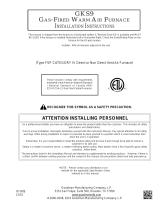
9
To maximize heat exchanger life, the combustion air must
be free of chemicals which form corrosive acidic compounds
in the combustion gases.
Combustion Air Quality
The recommended source of combustion air is to use the
outdoor air supply. However, the use of indoor air in most
applications is acceptable except as follows:
1. If the furnace is installed in a confined space it is
recommended that the necessary combustion air come
from the outdoors by way of attic, crawl space, air duct,
or direct opening.
2. If outdoor combustion air is used, there must be no
exposure to the installations or substances listed in
Item 3 below.
3. The following types of installation may require Out-
door Air for combustion, due to chemical exposures:
• Commercial buildings
• Buildings with indoor pools
• Furnaces installed in laundry rooms
• Furnaces installed in hobby or craft rooms
• Furnaces installed near chemical storage areas
Exposure to the following substances in the combus-
tion air supply may also require Outdoor Air for
combustion:
• Permanent wave solutions
• Chlorinated waxes and cleaners
• Chlorine based swimming pool chemicals
• Water softening chemicals
• De-icing salts or chemicals
• Carbon tetrachloride
• Halogen type refrigerants
• Cleaning solvents (such as perchloroethylene)
• Printing inks, paint removers, varnishes, etc.
• Hydrochloric acid
• Cements and glues
• Antistatic fabric softeners for clothes dryers
• Masonry acid washing materials
!
WARNING:
Furnace installation using methods other than
those described in the following sections must
comply with the National Fuel Gas Code and all
applicable local codes to provide sufficient
combustion air for the furnace.
Installation In An Unconfined Space
An unconfined space is an area including all rooms not
separated by doors with a volume greater than 50 cubic feet
per 1,000 Btuh of the combined input rates of all appliances
which draw combustion air from that space.
For example, a space including a water heater rated at
45,000 Btuh input and a furnace rated at 75,000 Btuh
requires a volume of 6,000 cubic feet [50 x (45 + 75) =
6,000] to be considered unconfined. If the space has an 8
foot ceiling, the floor area of the space must be 750 square
feet (6,000 / 8 = 750). In general, a furnace installed in an
unconfined space will not require outside air for combustion.
However, in “tight” buildings (with weather stripping and
caulk to reduce infiltration), it may be necessary to provide
outside air to ensure adequate combustion and venting,
even though the furnace is located in an unconfined space.
Installation In A Confined Space
A confined space is an area with volume less than 50 cubic
feet per 1,000 Btuh of the combined input rates of all
appliances drawing combustion air from that space. Furnace
closets, small equipment rooms and garages are confined
spaces. Furnaces installed in a confined space which
supply heated air to areas outside the space must draw
return air from outside the space and must have the return
air ducts tightly sealed to the furnace. A confined space
must have two openings into the space for combustion
air. One opening must be within 12 inches of the
ceiling, and the other must be within 12 inches of the
floor. The required sizing of these openings is determined
by whether inside or outside air is used to support
combustion, the method by which the air is brought to the
space, and by the total input rate of all appliances in the
space.
Downflow Warning (*RK Models):
The design of the downflow furnace is certified for natural
or propane gas and for installation on non-combustible
flooring. A special combustible floor sub-base is required
when installing on a combustible floor. Failure to install the
sub-base may result in fire, property damage and personal
injury. The special downflow sub-bases are factory sup-
plied accessories, part numbers 902974, 902667, and
904108 and 904165. 904165 is an adjustable Sub-Base Kit
and can be used on all cabinet sizes. When the furnace is
installed on a factory or site-built cased air conditioning
coil, the sub-base is not necessary. However, the plenum
attached to the coil casing must be installed such that its
surfaces are at least 1" from combustible construction.
!
CAUTION:
The downflow sub-base must not be installed
directly on carpeting, tile, or any combustible
material other than wood flooring.
A gas-fired furnace installed in a residential garage must be
installed so the burners and the igniter are located not less




















